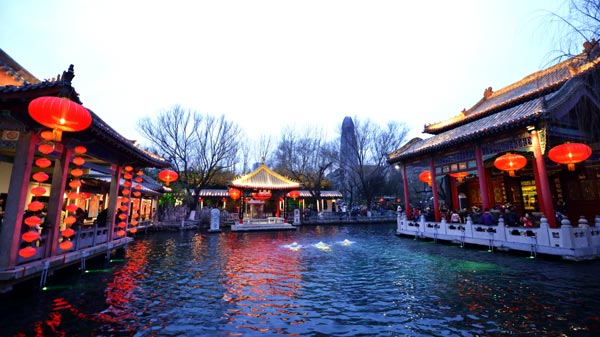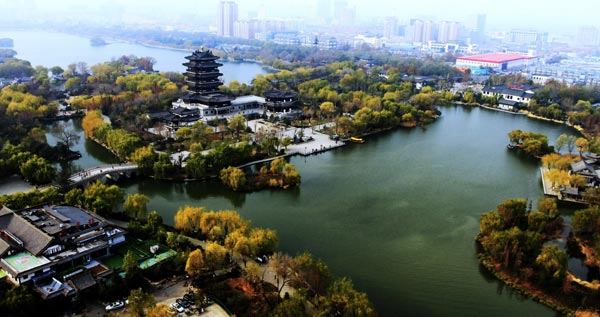


Jinan, capital of Shandong province, is 500 kilometers south of Beijing and widely known as the City of Springs.
It had 151 artesian springs within its 3.26-square-kilometer old city limit in the mid-19th century. Only 72 springs have survived the city's modernization and today they are treasured by locals.
The artesian wells bubble from the hydraulic pressure caused by the geographical drop of the location on which the city is built, with Mount Tai-shan to its south and the lower part of the Yellow River to its north.
The southern hilly area, which also collects and generates the springwater, is 500 meters higher than the river plain to the north. The groundwater flows downwards and gushes out at the foot of the hills.
Baotu Spring, made up of three big torrents of springs, is one of the most famous springs in the center of the downtown area, spraying an average of 240,000 tons of drinkable water every day.
The spring water maintains a constant temperature of 18 C throughout the year, creating fairy-tale visual effects in winter with misty vapor rising from the dark green water pool built for it.
There are four famous springs left in Jinan today, namely Baotu Spring, Pearl Spring, Black Tiger Spring and Five Dragon Spring.
Ancient pavilions, bridges, gardens and pagodas were built in the parks surrounding the springs since ancient times. The oldest building dates back to the Tang Dynasty (AD 618-907) and most are works of the Qing Dynasty (1644-1911).
The Baotu Spring, Pearl Spring and Five Dragon Spring parks used to be private gardens of rich and powerful local families. The delicate gardens boast a good combination of springs, plants, rockery, yards and buildings, a rare arrangement in northern China.
Calligraphy works of two Song Dynasty (960-1279) poets Li Qingzhao and Xin Qiji, who were both born in Jinan, are exhibited in the parks with a host of ancient stone tablets carved with words of praise left by the literati from the ensuing dynasties.
The Black Tiger Spring, located beside the ancient city moat, consists of three springs where water runs through three carved tiger heads in a stone pool.
Jinan has a civilized history of 2,400 years. The current city format was designed in the Tang Dynasty. The ancient city planners constructed a delicate waterway system collecting the springwater from almost every community in the old city with small and big, sealed and open, canals.
The buildings, yards, roads and bridges made it easy for residents to obtain springwater from the canals for drinking and daily use.
Willows and lotuses are planted everywhere in the city along the waterway and beside the spring pools.
Some big springwater pools, such as the Wangfu Pool, measure nearly 1,000 square meters and are popular "water parks" for the adults and children throughout the year. They're part of happy childhood memories for many adults today.
"I met my wife here during winter while swimming," recalls a local resident in his 50s, who lives beside the Wangfu Pool. "Springwater is part of the neighborhood. All families teach the children not to throw trash or pour wastewater into the spring waterway."
Copyright ©1999-2018
Chinanews.com. All rights reserved.
Reproduction in whole or in part without permission is prohibited.